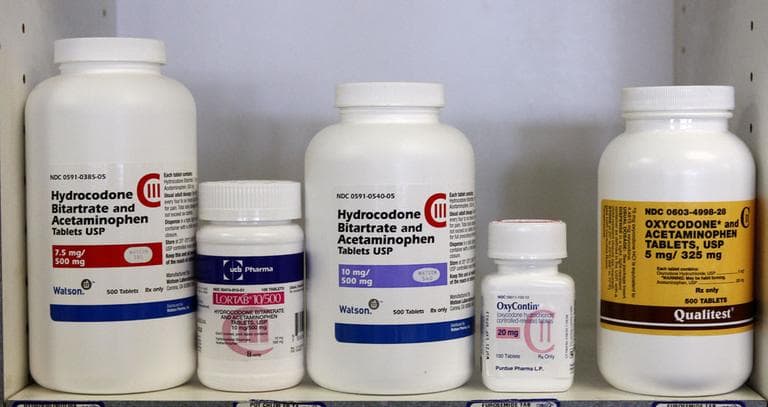Advertisement
Taking It To Feel Normal: My Oxycodone Experience

It was a Sunday night. Perched on my bed, I went through my ritual and took a swig of water and swallowed the two small white pills in my orange prescription bottle. "This is it," I told myself, "back to normal life." After a successful spinal fusion surgery, I was ready to rid myself of the last of the oxycodone I had been taking for six weeks to manage the pain in my back.
"Sales of painkillers reached about $8.5 billion last year, compared with $4.4 billion in 2001, according to the consulting firm IMS Health."
The New York Times
The next morning, I skipped all of my daily doses. Nausea and weakness slowly started to creep into my body. I lay on my couch and flipped through the cable channels on TV, intent on not letting it get to me. But by Monday night, I lay in bed practically twitching, as an intense jittery feeling spread through my upper torso. I tossed and turned until dawn, breaking a sweat as I repeatedly stretched one arm, then the other, as something akin to having consumed several cans of Red Bull continued to wreak an internal havoc inside of me.
So on Tuesday night, after taking the day off from my part-time, work-from-home status, I gave up. I reached back into that bottle and swallowed two more pills. Within minutes, I started to feel more normal again.
This is what withdrawal feels like.
My doctor had sent me home with paperwork for my narcotics, which explained that I should not quit narcotics cold turkey, but should call their office to get instructions on slowly cutting down. This would help me avoid those nasty side effects I was feeling. So after calling my doctor's office, I got back on oxycodone.
Painkillers Lead To Rise In Addiction
There are others like me out there who have also been taking it for legitimate reasons such as pain management after a major operation. But some have taken oxycodone, and other highly addictive narcotics, for much longer. And a new report says the sale of these prescription meds is leading to a rise in the number of addictions, now at epidemic levels, The Wall Street Journal reports:
Sales of the nation's two most popular prescription painkillers have exploded in new parts of the country, an Associated Press analysis shows, worrying experts who say the push to relieve patients' suffering is spawning an addiction epidemic.
From New York's Staten Island to Santa Fe, N.M., Drug Enforcement Administration figures show dramatic rises between 2000 and 2010 in the distribution of oxycodone, the key ingredient in OxyContin, Percocet and Percodan. Some places saw sales increase sixteenfold.
Meanwhile, the distribution of hydrocodone, the key ingredient in Vicodin, Norco and Lortab, is rising in Appalachia, the original epicenter of the painkiller epidemic, as well as in the Midwest.
What struck me is that I had to take the oxycodone just to feel normal. I don’t feel high when I take it, nor do I feel a heightened sense of... anything. I just feel like I can get through my day.
Pain Management vs. Possible Dependency
This is not just an issue of black market sales or the curious teen popping pills from their parent’s medicine cabinet. Doctors are more likely than ever to prescribe opioids like oxycodone, methadone, OxyContin and others, for pain management purposes, according to this New York Times piece:
“Doctors are prescribing like crazy,” said Dr. C. Richard Chapman, the director of the Pain Research Center at the University of Utah.
Medical professionals have long been on high alert about powerful painkillers like OxyContin because of their widespread abuse by teenagers and others for recreational purposes.
Now the alarm is extending from the street to an arena where the drugs had been considered legitimate and safe: doctors’ offices where they are prescribed — and some say grossly over-prescribed — for the treatment of long-term pain from back injuries, arthritis and other conditions.
“We started on this whole thing because we were on a mission to help people in pain,” Seattle Dr. Jane C. Ballantyne told the Times, in describing the medical profession’s embrace of opioids. “But the long-term outcomes for many of these patients are appalling, and it is ending up destroying their lives.”
New Policies Aim To Curb Painkiller Usage
In 2011, Washington state passed a law requiring doctors to refer patients on high dosages of opioids to see pain specialists if their condition did not improve. And at the federal level, the Obama administration announced last year it planned to introduce legislation that would require doctors prescribing opioids to undergo several hours of mandatory training — an initiative the Food and Drug Administration signaled it would do in 2008, but ended up backing out of two years later, according to the Times.
Now that I've spent the past two weeks cutting down my oxycodone dosage every few days, the weakness and other withdrawal symptoms have for the most part subsided. Looking at this issue now with my own (albeit relatively short-lived) experience taking these highly addictive pills, I can say that regardless of whatever policies are put into place to curb addiction, I have a greater admiration for people overcoming it.
This program aired on April 12, 2012. The audio for this program is not available.